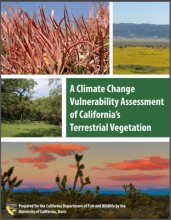A climate change vulnerability assessment of California’s terrestrial vegetation

This report presents the results of a climate vulnerability analysis of the terrestrial vegetation of California. The assessment is based on two global climate models (GCMs) and two emission scenarios that were selected from among 12 considered to represent a range of future conditions for California by the end of the 21st century. Thirty one natural vegetation macrogroups are identified in the map, covering 99.87% of the state’s natural terrestrial vegetation.
Four analyses were conducted on 29 macrogroups and partial analyses were conducted on the additional two. All results are presented in the main report. The first two analyses use biological traits of the dominant species comprising each macrogroup to estimate the sensitivity to changes in climate, and possible adaptive capacity that the vegetation may exhibit. The third analysis assesses the exposure to changing climate that each vegetation type is projected to experience at the locations it currently occupies. The final analysis estimates the spatial disruption, or movement that will be required to depart areas no longer climatically suitable or to establish in newly suitable areas. The scores were combined to provide a vulnerability ranking that is cross-comparable among the terrestrial vegetation types.
The vulnerability data in raster format can be accessed here: Climate Change Vulnerability Assessment of California's Terrestrial Vegetation.
Thorne, J.H., R.M. Boynton, A.J. Holguin, J.A.E. Stewart, & J. Bjorkman. (2016) A climate change vulnerability assessment of California’s terrestrial vegetation. California Department of Fish and Wildlife (CDFW), Sacramento, CA.
